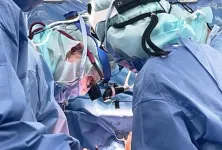(Press-News.org) Unlocking the power of nanopores
Poking holes through membranes with atomic accuracy to build pocket-sized ‘molecule detectives’
Brussels/Washington 19/07/2024 - Transmembrane β-barrel pores (TMBs) are extensively used for single-molecule DNA and RNA sequencing. They enable the miniaturization of a wide array of sensing and sequencing applications into portable USB-size devices and point-of-care technologies. A team of Belgian and American researchers has now described a general approach to design TMB pores from scratch with custom shapes and properties, opening up new opportunities for single-molecule analytics. Their results were published in Science.
Rolling out new barrels …
Protein nanopores are the holy grail in the field of analytical biology. These nanometer-sized proteins form regular pores in lipid membranes and are widely used for single-molecule DNA and RNA sequencing. They hold a considerable potential to advance a broad range of sensing and sequencing applications by taking them out of specialized labs and into portable devices. However, current approaches to engineering nanopore sensors are limited to naturally occurring proteins, which have evolved for very different functions and are less than ideal starting points for sensor development.
Research led by the VIB-VUB Center for Structural Biology (Belgium) and the University of Washington School of Medicine (USA) has taken on the challenge of designing these protein ‘barrels’ from scratch, with the ultimate goal of controlling the shape and chemistry on a molecular level. With the help of computational design, the researchers developed methods to design stable nanopore channels with tunable pore shapes, sizes, and conductance. Compared to natural pores, the signal generated by the designed TMBs was remarkably stable and quiet. Collaborators in the laboratory of Sheena Radford (University of Leeds) and Sebastian Hiller (Biozentrum, University of Basel) found that the designs folded into stable 3D structures. This opens the door to designing nanopore channels de novo that are suitable for many applications of interest in research and industry.
“These developments are very exciting. When we started with this idea a few years ago, many people thought it was impossible, because the design and folding of β-sheets is incredibly complex, let alone in lipid membranes. Now we have shown that we can successfully design nanopores with a high success rate, which have stable and reproducible conductance.” - Dr. Anastassia Vorobieva, group leader at the VIB-VUB Center for Structural Biology.
… and putting them to good use
As the next step, the researchers put their design method to the test. Nanopores that can detect very small molecules such as metabolites would be extremely useful tools for metabolomic and diagnostic analysis, which currently require large, specialized lab equipment. The design of functional small-molecule sensors remains challenging because of the complexity of protein-ligand interactions. Hence, the pores need to have a highly complementary shape to the small molecule of interest. A team from the laboratory of UW Medicine biochemistry professor and HHMI Investigator David Baker successfully designed new proteins that can specifically bind small-molecule metabolites. They split the proteins into three parts and fused the parts into the loops of a TMB pore. They found that they could directly detect single-molecule binding events using such constructs.
“This collaboration is a great example of what's possible with protein design. Rather than repurposing biomolecules from nature, we can now create the functions we want from first principles." – Prof. Dr. David Baker, professor at the University of Washington School of Medicine and HHMI investigator.
The positive results prove that nanopore design can complement mass spectrometry and other analytical methods that require big labs and big setups because the technology is smaller and more accessible. Although we are still quite a bit removed from this point, the researchers envision a future in which portable devices with different nanopores can sense a range of metabolites, proteins, and small molecules, or even do biomolecular sequencing.
Funding and Collaborations
The paper, “Sculpting conducting nanopore size and shape through de novo protein design,” appears in the July 19 edition of Science. The research team included scientists from the VUB-VIB Center for Structural Biology, UW Medicine, University of Virginia School of Medicine, University of Leeds, and University of Basel. Computational resources and services used in this work were provided by the VSC (Flemish Supercomputer Center), funded by the Research Foundation - Flanders (FWO) and the Flemish Government. The research team was funded by an FWO-EOS grant.
END
Unlocking the power of nanopores
Poking holes through membranes with atomic accuracy to build pocket-sized ‘molecule detectives’
2024-07-18
ELSE PRESS RELEASES FROM THIS DATE:
Genetic study highlights importance of diversity in understanding health disparities
2024-07-18
PHILADELPHIA— The majority of genetic studies focus on people of European descent, which limits the understanding of how genes influence health in other populations. Researchers at the Perelman School of Medicine at the University of Pennsylvania and the Corporal Michael J. Crescenz VA Medical Center, have partnered with a team of researchers at the Department of Veterans Affairs and the Department of Energy Oak Ridge and Argonne National Laboratories to conduct large-scale studies with diverse groups to better ...
Unhealthy sleep linked to diabetes in a diverse population
2024-07-18
Persistently unhealthy sleep, either not enough or too much, is associated with a significantly increased risk of Type 2 diabetes in a racially and economically diverse adult population, an international team of researchers has reported.
While previous research has linked suboptimal sleep durations to increased diabetes risk, the current report, published in the journal Diabetologia, extended these findings to a large cohort of primarily low-income, middle- to older-age Black and white adults in the southeastern United States.
“Our study contributes new information to support the importance of sleep health in midlife, particularly maintaining ...
Ochsner Health named among America’s Greatest Workplaces by Newsweek
2024-07-18
NEW ORLEANS, La. – For the second consecutive year, Ochsner Health, the leading nonprofit healthcare provider in the Gulf South, has been named one of America’s Greatest Workplaces for 2024 by Newsweek and Plant-A Insights Group. Ochsner’s inclusion on this year’s list highlights the health system’s dedication to delivering excellence in inclusivity, employee empowerment and innovative culture.
Newsweek and Plant-A Insights Group recognize the America’s Greatest Workplaces in the United States by conducting a large-scale employer ...
Is climate change keeping patients from vital doctor appointments?
2024-07-18
Temperature extremes, becoming increasingly frequent due to growing global climate change, are associated with higher rates of missed primary care appointments, according to a recently published study from Drexel University researchers in the American Journal of Preventive Medicine.
The researchers found that rates of missed appointments increased by 0.72% for every 1°F decrease in daily maximum temperatures below 39°F and increased by 0.64% for every 1°F increase above 89°F. Patients 65 and older and those with ...
How pollution may remain in water after oil spill cleanups
2024-07-18
Oil drops from underwater oil spills can break into tinier droplets at the surface that remain suspended in the water, according to research from the University of Illinois Chicago. That means cleanups after disasters like the Deepwater Horizon spill may be removing less oil from the environment than was thought.
Because oil is lighter than water, it rises through the ocean after spills, which are usually caused by leaking underwater pipelines or sometimes by natural processes. It was believed that when these ...
World’s first method: Successful surgery for a rare congenital heart disease “scimitar syndrome”
2024-07-18
Scimitar syndrome, a rare congenital heart disease, involves an anomalous pulmonary venous return where the right pulmonary veins return to the inferior vena cava instead of the left atrium. It is mainly diagnosed in infants, with an estimated prevalence of 1–3 per 100,000 births. Delayed treatment can lead to pulmonary hypertension, right heart failure, respiratory failure, heart arrhythmia, and growth disorders.
This syndrome is characterized by anomalous pulmonary venous drainage to the inferior vena cava, and the usual surgical repair involves re-implanting the right pulmonary veins (scimitar vein) to the left atrium or creating an intra-atrial tunnel to ...
Major computing society endorses efforts to make digital accessibility part of the Americans with Disabilities Act
2024-07-18
The Association for Computing Machinery’s US Technology Policy Committee (USTPC) has released a Statement in Support of Mandatory Comprehensive Digital Accessibility Regulations. The US Department of Justice recently updated the Americans with Disabilities Act (ADA), a civil rights law that prohibits discrimination based on disability, with requirements for the accessibility of web content and mobile applications. The aim of the revision to the ADA is to ensure that services, programs and activities provided by state and local governments online ...
When you eat may impact your overall health, nutrition experts say
2024-07-18
Philadelphia, July 18, 2024 – Accumulating evidence on the effect of the time of eating in relation to our circadian rhythm and metabolism shows that when we eat may influence our overall health and well-being. A special issue of the Journal of the Academy of Nutrition and Dietetics (JAND) on chrononutrition, published by Elsevier, examines the effects of various fasting regimens and covers safety considerations and practical guidance.
The field of chrononutrition is gaining traction as it explores the relationship between temporal eating patterns, circadian rhythms, and metabolism for optimal health.
Guest Editor Krista Varady, PhD, Department of Kinesiology and Nutrition, ...
Researcher receives NASA funding to study ozone pollution
2024-07-18
NORMAN, OKLA. – University of Oklahoma professor Chenghao Wang has received three years of funding through the National Aeronautics and Space Administration Early Career Investigator Program in Earth Science. Wang, an assistant professor in both the OU School of Meteorology and the Department of Geography and Environmental Sustainability, will study compound heat and ozone pollution episodes in urban environments.
Heat waves and air pollution are two increasingly occurring challenges that disproportionately impact urban areas. When multiple stressor events happen simultaneously, these compound events can have more significant impacts than isolated events. ...
New ECDC Director Pamela Rendi-Wagner emphasises importance of restoring and reinforcing public trust in science after pandemic, in editorial for Eurosurveillance
2024-07-18
In an editorial for the scientific journal Eurosurveillance, the incoming ECDC Director Dr Pamela Rendi Wagner outlined her vision for the European Union’s public health agency, highlighting the mounting challenges to public health after the COVID-19 pandemic, including war in Europe, climate change, and increasing social inequalities. She also emphasised the importance of reinforcing and restoring public trust in science.
Current challenges in public health
“War, flooding and the effects of ...
LAST 30 PRESS RELEASES:
University of Oklahoma researcher awarded funding to pursue AI-powered material design
Exploring how the visual system recovers following injury
Support for parents with infants at pediatric check-ups leads to better reading and math skills in elementary school
Kids’ behavioral health is a growing share of family health costs
Day & night: Cancer disrupts the brain’s natural rhythm
COVID-19 vaccination significantly reduces risk to pregnant women and baby
The role of vaccination in maternal and perinatal outcomes associated with COVID-19 in pregnancy
Mayo Clinic smartwatch system helps parents shorten and defuse children's severe tantrums early
Behavioral health spending spikes to 40% of all children’s health expenditures, nearly doubling in a decade
Digital cognitive behavioral treatment for generalized anxiety disorder
Expenditures for pediatric behavioral health care over time and estimated family financial burden
Air conditioning in nursing homes and mortality during extreme heat
The Alps to lose a record number of glaciers in the next decade
What makes a good proton conductor?
New science reporting guide published for journalists in Bulgaria
New international study reveals major survival gaps among children with cancer
New science reporting guide published for journalists in Turkey
Scientists develop a smarter mRNA therapy that knows which cells to target
Neuroanatomy-informed brain–machine hybrid intelligence for robust acoustic target detection
Eight SwRI hydrogen projects funded by ENERGYWERX
The Lundquist Institute and its start-up company Vitalex Biosciences Announces Strategic Advancement of Second-Generation fungal Vaccine VXV-01 through Phase 1 Trials under $40 Million Competitive Con
Fine particles in pollution are associated with early signs of autoimmune disease
Review article | Towards a Global Ground-Based Earth Observatory (GGBEO): Leveraging existing systems and networks
Penn and UMich create world’s smallest programmable, autonomous robots
Cleveland researchers launch first major study to address ‘hidden performance killer’ in athletes
To connect across politics, try saying what you oppose
Modulating key interaction prevents virus from entering cells
Project explores barriers to NHS career progression facing international medical graduates
Jeonbuk National University researchers explore the impact of different seasonings on the flavor perception of Doenjang soup
Two Keck Medicine of USC Hospitals named Leapfrog Top Teaching Hospitals
[Press-News.org] Unlocking the power of nanoporesPoking holes through membranes with atomic accuracy to build pocket-sized ‘molecule detectives’




